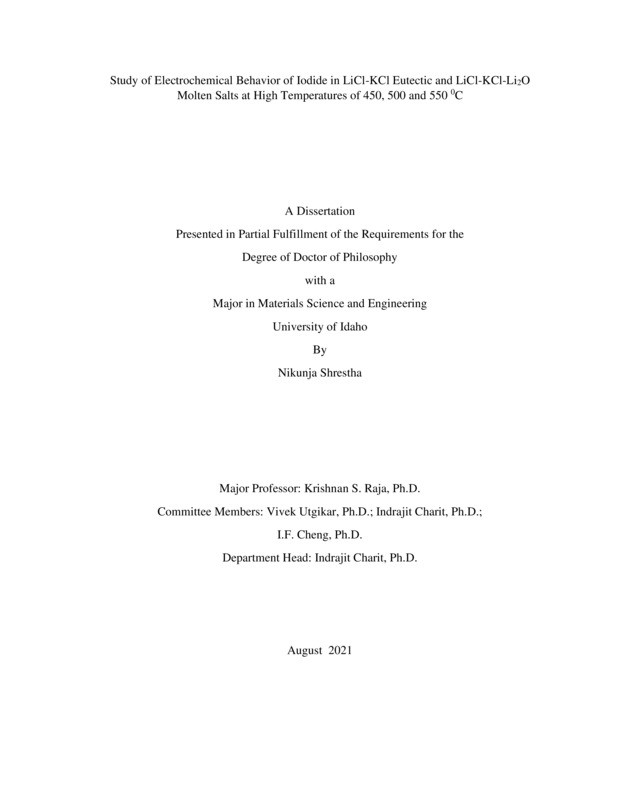Study of Electrochemical Behavior of Iodide in LiCl-KCl eutectic and LiCl-KCl-Li2O Molten salts at High Temperatures of 450, 500 and 550 C
Shrestha, Nikunja. (2021-08). Study of Electrochemical Behavior of Iodide in LiCl-KCl eutectic and LiCl-KCl-Li2O Molten salts at High Temperatures of 450, 500 and 550 C. Theses and Dissertations Collection, University of Idaho Library Digital Collections. https://www.lib.uidaho.edu/digital/etd/items/shrestha_idaho_0089e_12059.html
- Title:
- Study of Electrochemical Behavior of Iodide in LiCl-KCl eutectic and LiCl-KCl-Li2O Molten salts at High Temperatures of 450, 500 and 550 C
- Author:
- Shrestha, Nikunja
- Date:
- 2021-08
- Embargo Remove Date:
- 2023-09-01
- Keywords:
- high temperature iodide LiCl-KCl LiCl-KCl-Li2O molten salts pyroprocessing
- Program:
- Materials Science
- Subject Category:
- Engineering
- Abstract:
-
Several radioactive iodine isotopes are formed during neutron induced fission of nuclear fuel, and these radionuclides are retained within the fuel matrix and by the containment provided by the fuel cladding and 129I is one of concern. During reprocessing of the used nuclear fuel, a significant fraction of iodine (78.9 mg/g of heavy metal) was reported to be retained in the molten salt as iodide (I-) such as NaI, CsI, AgI PdI2, UI3, ZrI4, 3HI. Accumulation of iodide species could significantly affect the performance of the electro-refiners that are used for electrolytic reduction of actinides during pyro-processing of used nuclear fuels. Therefore, it is important to understand the electrochemical speciation of iodide in the LiCl-KCl eutectic and LiCl-Li2O molten salts. The electrochemistry of iodine/iodide couples has been extensively studied in aqueous and non-aqueous conditions at room temperature because of its application in dye-sensitized solar cells, and synthetic chemistry. However, only very limited work has been reported in high temperature molten salts.In this research, electrochemical behavior of iodide in LiCl-KCl eutectic, LiCl-KCl-Li2O, and LiCl-KCl+1 - 5 wt%CeCl3 molten salts were investigated at temperatures in the range of 450 – 550 ºC using different electrochemical techniques such as cyclic voltammetry, electrochemical impedance spectroscopy and square wave voltammetry. Iodide was present in the form of potassium iodide and its concentration varied from 1 – 10%. Ce(III) was added as a surrogate of U(III) to evaluate the effect of iodide on the reduction process. The diffusivity of Ce(III) in LiCl-KCl eutectic at 450 ºC decreased from 0.5 X 10-5 cm2/s to 2.5, 1.5, 1.1 x 10-5 cm2/s with the addition of 1, 5, and 10 wt% KI. The reduction potential of Ce(III) shifted to more negative potentials with the addition of KI. This presentation will discuss the oxidation of iodide species (I- and I3-), and their interaction with chloride by forming interhalide compounds. Formal potentials of reaction steps, number of electrons involved in the reactions, and diffusivities of various ions will be presented, and how these data are helpful for pyroprocessing of the used nuclear fuels are discussed.
- Description:
- doctoral, Ph.D., Materials Science -- University of Idaho - College of Graduate Studies, 2021-08
- Major Professor:
- Raja, Krishnan Dr; Utgikar, Vivek Dr
- Committee:
- Raja, Krishnan Dr; Utgikar, Vivek Dr; Charit, Indrajit Dr. ; Cheng, I. Francis Dr.
- Defense Date:
- 2021-08
- Identifier:
- Shrestha_idaho_0089E_12059
- Type:
- Text
- Format Original:
- Format:
- application/pdf
- Rights:
- In Copyright - Educational Use Permitted. For more information, please contact University of Idaho Library Special Collections and Archives Department at libspec@uidaho.edu.
- Standardized Rights:
- http://rightsstatements.org/vocab/InC-EDU/1.0/

